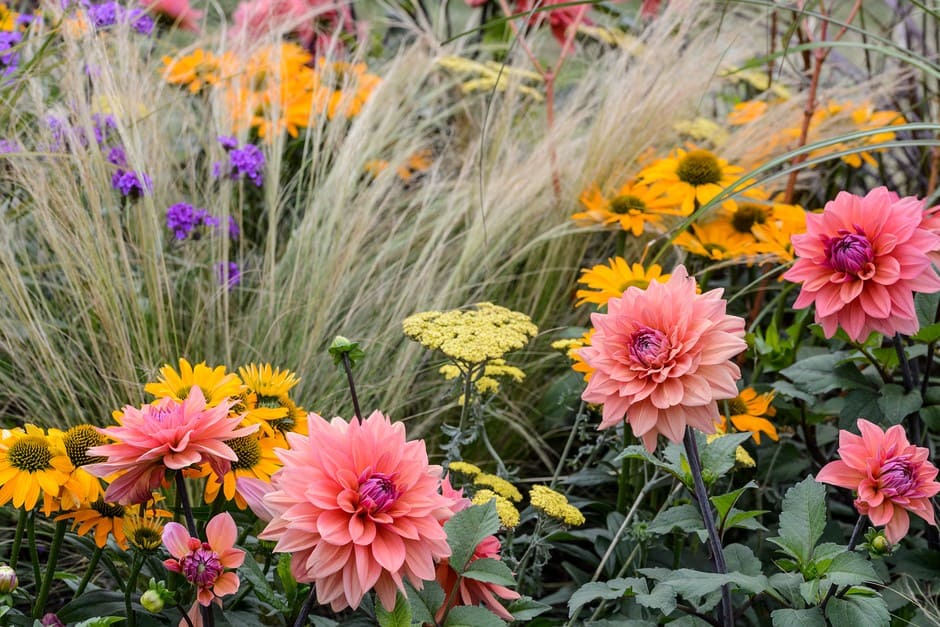Introduction
Tall perennial flowers, with their majestic presence and enduring blooms, offer an enchanting addition to any garden landscape. From vibrant delphiniums to elegant hollyhocks, these towering floral wonders captivate the eye and elevate the ambiance of outdoor spaces. In this comprehensive guide, we delve into the world of tall perennial flowers, exploring their diverse varieties, cultivation techniques, and the transformative beauty they bring to gardens.
Exploring the Majesty of Tall Perennial Flowers
Tall perennial flowers encompass a diverse array of botanical marvels, each boasting unique characteristics and visual appeal. Let’s embark on a journey to discover some of the most captivating specimens:
Delphiniums: Reaching for the Sky
Standing tall with their spiky blooms in hues of blue, purple, pink, and white, delphiniums epitomize elegance and grace in the garden. These towering perennials, often reaching heights of 4 to 6 feet, make a striking focal point in borders and cottage-style gardens. With proper care and regular deadheading, delphiniums continue to dazzle with their lofty flower spikes throughout the summer months.
Hollyhocks: Towering Elegance
With their towering spires adorned with delicate, cup-shaped flowers, hollyhocks add a touch of old-world charm to any garden setting. These biennial or short-lived perennial plants can soar to impressive heights of 6 to 8 feet, creating a stunning backdrop against walls or fences. Available in an array of colors, including shades of pink, red, yellow, and white, hollyhocks evoke a sense of nostalgia and romance in the garden.
Foxgloves: Nature’s Towering Beauties
Admired for their architectural form and enchanting blooms, foxgloves stand tall as one of the most beloved tall perennial flowers. Their tubular flowers, arranged in vertical spikes, beckon bees and butterflies, adding movement and life to the garden. While foxgloves are biennial, self-seeding ensures a continuous display of these majestic blooms year after year.
Cultivating Tall Perennial Flowers: Tips for Success
Growing tall perennial flowers requires careful attention to their specific needs and preferences. Here are some essential tips to ensure success:
Selecting the Right Location
Choose a sunny or partially shaded spot in your garden with well-draining soil for optimal growth. Tall perennial flowers thrive in locations with good air circulation and ample sunlight.
Providing Adequate Support
Due to their towering stature, many tall perennial flowers require support to prevent them from toppling over in strong winds or heavy rain. Install stakes or trellises around the plants to provide necessary support as they grow.
Regular Watering and Feeding
Keep the soil consistently moist, especially during the hot summer months, to promote healthy growth and abundant flowering. Additionally, fertilize tall perennial flowers with a balanced fertilizer to ensure they receive essential nutrients for vigorous growth.
Enhancing Your Garden with Tall Perennial Flowers
Integrating tall perennial flowers into your garden design offers endless opportunities for creativity and visual impact. Here are some ideas to inspire your landscape:
- Create a Backdrop: Plant tall perennial flowers against walls, fences, or hedges to create a stunning backdrop for smaller plants and ornamental features.
- Design Dramatic Borders: Line pathways or garden borders with tall perennial flowers to create a sense of depth and drama in your landscape design.
- Mix and Match: Combine different varieties of tall perennial flowers with contrasting colors, shapes, and textures to create dynamic and visually appealing plantings.
Frequently Asked Questions (FAQs)
How tall do perennial flowers grow?
Perennial flowers vary in height depending on the species and cultivar. Some can reach towering heights of 6 feet or more, while others stay relatively compact at around 2 to 3 feet.
Do tall perennial flowers require special care?
While tall perennial flowers generally require the same care as other garden plants, they may need additional support to prevent them from flopping over in windy conditions. Providing adequate support, regular watering, and occasional feeding can help ensure their optimal growth and performance.
When is the best time to plant tall perennial flowers?
The ideal time to plant tall perennial flowers is in early spring or fall, depending on the specific requirements of the plant. Spring-planted perennials have the entire growing season to establish their root systems, while fall-planted ones can benefit from cooler temperatures and ample moisture to establish themselves before winter.
How do I prevent tall perennial flowers from becoming too leggy?
To prevent tall perennial flowers from becoming leggy, pinch back the growing tips early in the season to encourage bushier growth and more compact habits. Additionally, providing adequate support, such as stakes or cages, can help prevent the plants from sprawling.
Are tall perennial flowers deer-resistant?
While no plant is entirely deer-proof, some tall perennial flowers, such as foxgloves and delphiniums, contain toxins or have hairy or spiky foliage that makes them less palatable to deer. However, individual deer may still browse on them if other food sources are scarce.
Can I divide tall perennial flowers?
Yes, many tall perennial flowers can be divided to propagate new plants or rejuvenate existing ones. Divide clumps of perennials in early spring or fall when the weather is cool and moist, and the plants are not actively flowering.
Conclusion
Incorporating tall perennial flowers into your garden design allows you to create a captivating and dynamic landscape that evolves with the seasons. Whether you opt for the stately elegance of delphiniums, the rustic charm of hollyhocks, or the ethereal beauty of foxgloves, these towering floral wonders promise to elevate the ambiance of your outdoor space. With proper care and cultivation, tall perennial flowers will continue to enchant and inspire for years to come.


